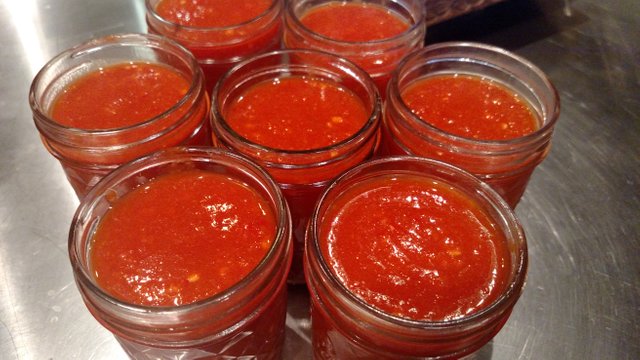Making Your Own Lacto-Fermented Hot Sauce
Hot sauce. Perfect for masking the true nature of the mystery meat in that roach coach burrito you bought. Great for an extra kick in those hair-of-the-dog Bloody Marys the morning after. An essential part of any macho feat of eating prowess.
Most hot sauces tend to be blended chillies mixed with a bit of salt and some vinegar to preserve it. Tabasco being a great example and you can find countless recipes online for making something similar.
When I make hot sauce (and other things), I prefer to use a fermentation process that's largely the same process as making beer or wine. Essentially, natural yeast turns sugars into CO2 and lactic acid. The acid then acts as a preserving agent like the vinegar. Instead of that sharp-biting acetic acid flavour, you get a smoother sourness of the lactic acid.
Lacto-fermentation processes like this also come with a bunch of probiotic benefits too.
The process itself is simple: A salt brine, packing, waiting and blending.
You'll need a few things:
- Chillies. Lots of them. Pick a variety of sweet, mild and spicy ones. I go to farmers markets and pick up whatever looks good.
- Some jars with lids (mason jars or clean pickle jars are fine).
- Enough salt to match 2% of the weight of the chillies and other ingredients.
- I usually also add a bunch of garlic, ginger, onion and capsicum (bell peppers). I like to add some carrot too -- it's a great source of sugars to get the yeast started, and adds to the colour.
Apart from the salt ratio, the other ratios are all down to personal preference and choice. The main ingredient will be the chillies, but don't be afraid to be a little heavy handed with the others.
The steps to hot sauce nirvana are as follows:
- Coarsely cut up the fruit, vegetables and herbs. The shape doesn't matter, but we will be looking to squeeze all of the air pockets out later, so shapes conducive to that will save you time. I keep the seeds, but do discard the stalks or any bruised or damaged parts of the fruit.
- Mix all of the fruit and spices in a bowl with the 2%-weight of salt.
- Let it sit for 2-3hrs. You'll notice that a bunch of liquid has been expelled and sits at the bottom of your bowl. This is what you want.
- Rinse the salt off and drain.
- Pack the fruit into your jar(s). You'll notice that as you pack it in, more juice and any air present are pushed out. It is critical to pack the fruit down so that the liquid covers the fruit entirely and there's no air pockets left. This creates the critical anaerobic environment that allows fermentation and prevents mold. If you don't have quite enough liquid, feel free to add a little salted water to bring the level up.
- Let it sit with the lid on for a week or two in a cool, dry place out of direct sunlight. Each day for the first few days, you'll notice plenty of bubbling, which is the yeast at work. During that period, unscrew the lid and screw it back on once a day. Just for enough time to let the excess CO2 escape but without letting anything else in.
- Blend it up, put it in clean jars and refrigerate. It'll last a year that way.
If you notice any mold, it's best to throw it out. But if you keep everything clean and you're patient, there's really not a lot that can go wrong.

@mattgeddes